
by Legalnaija | May 29, 2021 | Uncategorized
The fate of justice system within the four walls of Nigeria as a nation is crying for mercy. For a period of a year and six months, the wheel of justice is clogged, as uncertainty beclouds the entire justice system of the country, this is further amplified by the unfortunate sequence of events ranging from Corona virus Pandemic, EndSARS protest, Vacations, Holidays and Strike action by Nigerian Labour Congress (NLC) and Judicial Staff Union (JUSUN) at different periods within same time; all cumulating to compulsory holidays and a stop to the moving rail of the justice sector of the country.
Consequently, Legal Practitioners, Judges and all judicial actors who plays critical role in the legal and justice delivery system have been rendered redundant, while the fate of the Nigerian litigants and persons in dire need of effective justice delivery is hanging in the balance. The overall negative effects of these ugly trends have taken its toll on all citizens within and outside the country.
I have always said, and It is my belief that the two most important considerations witnessed and obviously manifested in any prosperous and/or great nation is good Leadership and effective Justice system; as every other heals and ills of any society rest on these two mighty pillars; resultantly, if the right persons are within the frame and structure of leadership and justice delivery of any nation, naturally there will be justice, security and peace in the land and same would bring about a prosperity and development.
It is of common knowledge that the Judicial Staff Union of Nigerian Judiciary has embarked on an indefinite strike from the first week of April, 2021 till date; all for reasons of seeking to effect compliance of Governors within the Thirty-Six States of the Federation with the necessary provisions of the Nigerian constitution, precedents and other laws; Judicial Financial Autonomy.
The question that keep begging for answer remains, How difficult could it be for our selfish and ‘care-less’ leaders to effect the content of a written law, particularly that of the constitution they duly swore to uphold and enforce? In a country like Nigeria, Oath of Office and/or allegiance to the constitution has manifestly become a joke; yet, no consequence for any malfeasance or deliberate misgivings made by our so called lawless leaders of law and order.
It is a notorious fact that majority of Governors and leaders in Nigeria never believes in legacy, they would promise heaven and earth, and as soon as they mount the podium of leadership, they soon forget that power is transient; impunity becomes the order of the day, they know nothing about leaving legacies. This same attitude had wrecked the country for too long? For how long would we continue in this perfidious trend and expect a great nation?
It is very unfortunate and embarrassing that we have Governor-Lawyers who know the right thing as clearly stated by our constitution and other laws, but failed to comply with such provision of judicial autonomy for selfish reasons. I suppose if all Governors fails, no Governor-Lawyer heading the important arm of the Executive should ordinarily fail by their callings. Methinks, it amounts to grave misconduct and flagrant breach of Oath of office. It simply amounts to grave illegalities.
A lot of lawyers are in leadership positions across the country as Governors, Deputy Governors, Ministers of the Federation, Commissioners; particularly, Attorney Generals; many of whom by their conducts, actions and inactions failed to do, encourage and/or lead by example by simply following the provisions of law; hence encouraged lawlessness and impunity within the system.
Section 81(3), 121(3) of the constitution of Nigeria is clear and unambiguous; its simply provides:
- (1) The President shall cause to be prepared and laid before each House of the National Assembly at any time in each financial year estimates of the revenues and expenditure of the Federation for the next following financial year.
(2) The heads of expenditure contained in the estimates (other than expenditure charged upon the Consolidated Revenue Fund of the Federation by this Constitution) shall be included in a bill, to be known as an Appropriation Bill, providing for the issue from the Consolidated Revenue Fund of the sums necessary to meet that expenditure and the appropriation of those sums for the purposes specified therein.
(3) The amount standing to the credit of the-
(a) Independent National Electoral Commission,
(b) National Assembly, and
(c) Judiciary, in the Consolidated Revenue Fund of the Federation shall be paid directly to the said bodies respectively; in the case of the Judiciary, such amount shall be paid to the National Judicial Council for disbursement to the heads of the courts established for the Federation and the States under section 6 of this Constitution.
- (1) The Governor shall cause to be prepared and laid before the House of Assembly at any time before the commencement of each financial year estimates of the revenues and expenditure of the State for the next following financial year.
(2) The heads of expenditure contained in the estimates, other than expenditure charged upon the Consolidated Revenue Fund of the State by this Constitution, shall be included in a bill, to be known as an Appropriation Bill, providing for the issue from the Consolidated Revenue Fund of the State of the sums necessary to meet that expenditure and the appropriation of those sums for the purposes specified therein.
(3) Any amount standing to the credit of the judiciary in the Consolidated Revenue Fund of the State shall be paid directly to the heads of the courts concerned.
Section 81(3) and section 121(3) of the provisions of the constitution above are clear and instructive enough.
Several judicial precedents as Judicial Staff Union of Nigeria v. Governors of the 36 States of Nigeria (2013), Suit No; FHC/ABJ/CS/667/13; Olisa Agbakoba v. FG & 2Ors. FHC/ABJ/CS/63/2013 gave judicial imprimatur to the essence of independent and financially free judiciary. By judicial pronouncements, Judicial autonomy is not only compulsory, it is a necessity, the importance of an independent of judiciary of any great nation cannot be over-emphasized.
President Buhari Executive Order 10, 2020 which was made granting financial autonomy to States Judiciary and Legislatures is the way to go in a Federation structure like Nigeria. The Executive Order 10 as signed by Nigerian President is simply in line with the provisions of Nigeria constitution, same gives power to the Accountant-General of the Federation to deduct from the allocations due to a state from the Federation Account, any sums appropriated for the legislature or judiciary of that state which the state fails to release to its legislature or judiciary as the case may be, and to pay the funds directly to the state’s legislature or judiciary concerned through the heads of each arms.
The immediate compliance and/or implementation of the above presidential directive would have been one of the turning points in the history of Nigeria governance; It is very unfortunate that when the executive order 10 was due for implementation, same was eventually suspended on intervention of Governors in Nigeria who prevailed on the president to suspend the said executive order without any valid reason; and funny enough, some of the Governors that prevailed on Mr. president are Governor-Lawyers, who ought to lead by example and influence others by setting a pace in allowing the prevalence of Rule of law and order.
The JUSUN Strike is needless, if only the Governors would obey the constitution. The country is bleeding on all fronts; all sectors of economy and national life are on trial. Let the Governors assist in creating a good, virile and stable society where law and order is given foremost importance. The judicial arm should be given utmost priority by total independence. Power is transient, and where there is no justice, there cannot be peace and development.
The strike action appears to be the satisfaction of the so called Governors who have made outright refusal to heed the yearning for justice through JUSUN. The free course of justice has been suspended indefinitely for unwarranted reasons and the lackadaisical postures of the relevant authorities. This is extremely bad for the governors themselves who would look up to the someday, especially when they are o more in power.
It would be wise, humane, law abiding and reputable for governors, most especially the learned ones, to give wings to the crawling bird of the Judiciary by allowing fiscal independence of the Judiciary in the interest of justice, in tandem with the constitution and the will of the people of Nigeria.
It’s a great shame for any Governor, particularly Lawyer-Governors to be fingered in this anomaly. It is simple, in line with your sworn Oath of office, comply with the law and there shall be justice and peace.
Richarmond O. Natha-Alade is a legal Practitioner and Executive Partner, Sun Natha-Alade & Partners (SNATHAP)
lordricharmond@gmail.com
www.snathap.com
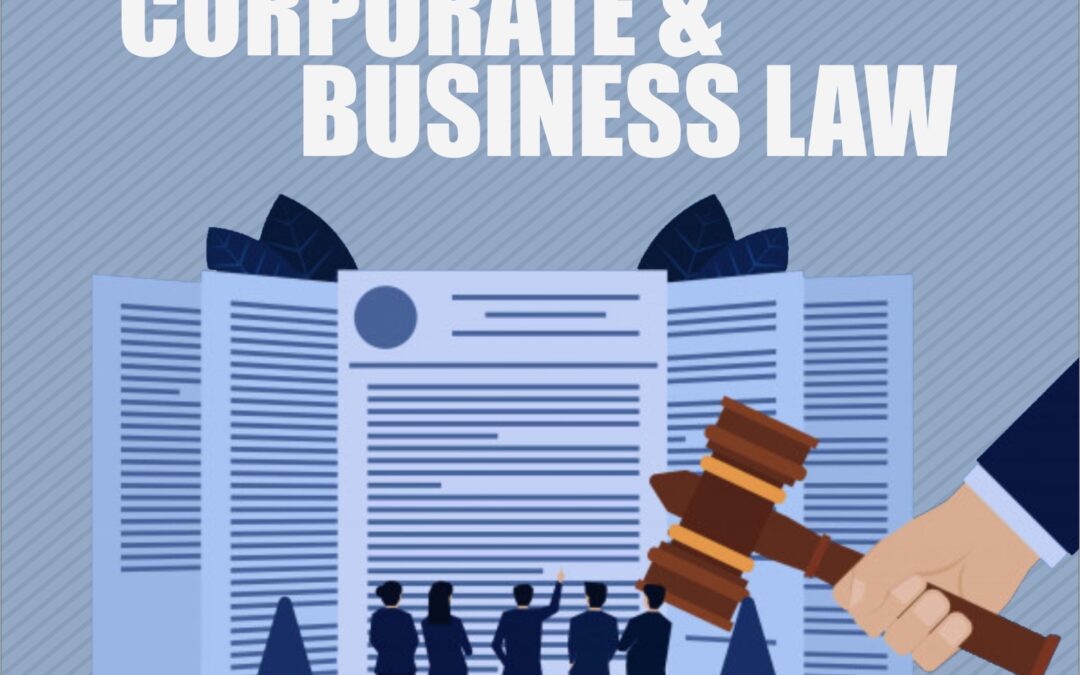
by Legalnaija | May 29, 2021 | Uncategorized
- What is Crowdfunding Intermediary License?
Crowdfunding is the process of raising funds to finance a project or business from the public (in exchange for the issuance of shares, debentures, or such other investment instrument) through an online platform called crowdfunding portal.
In order to set up and operate a crowdfunding portal in Nigeria, a crowdfunding intermediary license must be obtained from the Securities and Exchange Commission (“SEC”). The SEC has directed that all crowdfunding platforms in Nigeria must register and obtain license by 30th June 2021 or cease operation.
- What is the First Step in Setting up a Crowdfunding Platform?
The first step in setting up a crowdfunding business in Nigeria is to register a 100 million share capital company limited by shares with the Corporate Affairs Commission (“CAC”). The object clause of the company must be in line with a crowdfunding business.
To register a company for the operation of a crowdfunding portal, the promoters would need the following requirements:
- Two proposed names for the company (chosen names are subject to availability check and reservation);
- Names, addresses, phone numbers, emails, signature specimen and a means of identity (usually international passport) of the Subscribers/Shareholders and Directors;
- Information about the division of the shares amongst the shareholders;
- Registered address of the company (we may agree to use our law firm’s office as a tentative address for the company pending the grant of the license);
- A total of N1,345,000 (One Million Three Hundred and Forty-Five Thousand Naira) as registration cost, which is broken down as follows:
- Filing Fee of N505,000 payable to the CAC (Five Hundred and Five Thousand Naira) for 100million share capital company (This is because the CAC charges N10,000 for the 1million of the 100million share capital, and N5,000 for every subsequent 1million of the remaining 99million share capital);
- Stamp duty of N750,000 payable to Federal Inland Revenue Service (“FIRS”) (This is because the FIRS charges 0.75% of the 100million on the share capital of the company).
- Certified True Copy cost of N15,000 payable to CAC (This is because the CAC charges N5,000 for the certified true copy of the Certificate of incorporation, the Memorandum and Articles of Association (“MEMART”) and the Extract of the Shareholders/Directors’ History of the Company all of which would be needed for the crowdfunding intermediary license application).
- N75,000 facilitation and miscellaneous fee to cover fast track of the process, Remita charges for all payments to CAC and FIRS, courier and other expenses relating to incorporation and application for certified true copy of the Certificate of incorporation, the MEMART and the Extract of the Shareholders/Directors’ History.
Where the applicant company is already registered with the CAC but perhaps for a different business and or with a share capital below 100million, then it would be necessary for the company to pass necessary resolutions and file necessary documents with the CAC for the increment of the company’s shares to 100million and to amend the MEMART and its object clause to reflect crowdfunding business. Please note that this process of increase of share capital and amendment of the MEMART would attract some or all of the costs mentioned above.
- What is the Next Step?
Upon the registration of a new company (or increase of share capital and amendment of the MEMART of an existing company), an application for crowdfunding intermediary license can then be made to SEC. The application is to be submitted with the following documents:
- Certified true copy of the certificate of incorporation of the company;
- Certified copy of the MEMART (or amended MEMART) of the company;
- Latest copy of audited accounts or statement of affairs signed by its auditors and management accounts that are not more than thirty (30) days old as at time of filing with the Commission;
- CAC Form(s) showing Statement of Share Capital, Return of Allotment, and Particulars of Directors;
- Two copies of existing or proposed by-laws or rules, and such other document governing the conduct of subscribers on the crowdfunding platform;
- Sworn declaration to promptly furnish the Commission with copies of any amendments to its by-laws, rules, or codes;
- Information relating to market facilities;
- Detailed information about the crowdfunding system to be adopted by the company;
- Profile of the company including structure and profile of its Management and postal addresses of previous employers, bankers and nominated referees of sponsored individuals. It must also include the name(s) and address(es) of the company’s subsidiaries/associated companies/related entities, the type of their business and percentage holding in them;
- Detailed Curriculum Vitae and profiles of the promoters/shareholders, sponsored individuals and principal officers of the Crowdfunding Portal with a chronology of activities from Secondary School to date, all gaps in their employment and educational history should be explained;
- Copies of credentials and relevant certificates, originals will be required for sighting by the SEC;
- An application for registration of at least three (3) principal officers of the Crowdfunding Portal occupying the offices of managing director and two other officers. We usually advise that the two should be the chief operations officer (or compliance officer) and chief financial officer.
- Police clearance report for each Sponsored Individual and directors;
- Copy of a valid means of Identification of the Directors and the Sponsored Individuals of the Company;
- Sworn declaration to keep such records and render such periodic returns as may be specified by the Commission;
- Evidence of meeting the minimum paid-up capital requirement of N100 million in the audited accounts or statement of affairs of the company. The cash assets ratio shall be a minimum of 30% liquid assets and 70% fixed and other assets.
- Current Fidelity Insurance Bond valued at a minimum of 20% of the paid-up capital (i.e. N20,000,000).
- Operational manual of the company;
- Business plan;
- Bank statement of accounts operated by the Company for the last 6 months for existing company.
- Any other information required by the SEC.
- What are the applicable fees payable SEC for the crowdfunding intermediary license?
At the time of submission of the license application to SEC, the applicant company would be required to pay a total of N1,100,000 (One Million One Hundred Thousand Naira) to SEC. The fee requirement is broken down as follows:
- Filing/Application Fee – N50,000 (Fifty Thousand Naira);
- Processing Fee – N200,000 (Two Hundred Thousand Naira);
- Registration Fee – N500,000 (Five Hundred Thousand Naira);
- Sponsored Individual Fee – N50,000 (Fifty Thousand Naira) for each sponsored individual (not less than 3 sponsored individuals, i.e. N150,000).
- Miscellaneous Expenses of N200,000 for Police clearance for the three sponsored individuals, Remita charges courier and other expenses.
- What are the timelines for completing registration and obtaining the crowdfunding intermediary license?
The incorporation of the company usually takes 24 hours (i.e. 1 day). The crowdfunding intermediary license should be granted within 30 days after submission barring any query.
Please contact Koriat & Co. through admin@koriatlaw.com or 09067842241 if you require additional information about or assistance in making the application for crowdfunding intermediary license.
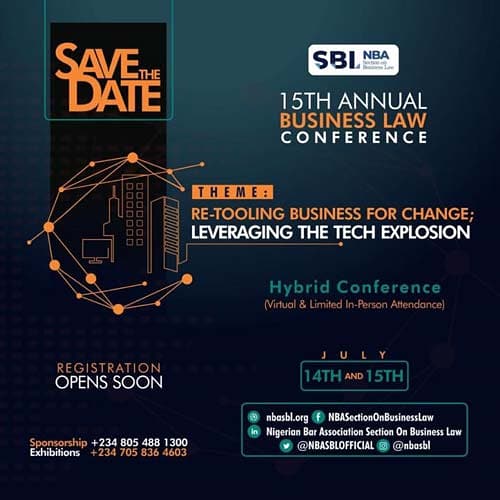
by Legalnaija | May 29, 2021 | Uncategorized

The Council of the Nigerian Bar Association Section on Business Law (NBA-SBL) and the 2021 Conference Planning Committee has announced the official Opening of REGISTRATION for the 15th Annual Business Law Conference scheduled to hold on Wednesday July 14th and Thursday, July 15th, 2021, with the theme: “Re-tooling Businesses for Change; Leveraging the Tech Explosion”
The Conference which is a hybrid of virtual and in-person attendance, boasts of a remarkable lineup of local and international speakers from the legal, tech and business communities, with equally stimulating sessions curated to generate thought-provoking conversations, as participants explore the fast-developing relationship between frontier technologies across the world and the business law space.
Topics for discussion include, Alternative currencies in the digital age; The Future of Digital Financial Services & Financial Inclusion, Technology and the future of elections in Nigeria: E-Voting, mail voting; as well as a session on “Tech Innovation and E-Governance”; which will be attended by the Governor of Lagos, Babajide Sanwo-Olu, Kayode Fayemi, Governor of Ekiti State, Seyi Makinde of Oyo State and Godwin Obaseki of Edo State.
One of the highpoints of the conference is a Special Mentoring Session, showcasing three generations of business lawyers who would spotlight and x-ray the lows and highs of leadership and practice development across a Fireside Chat and a Q&A session with the younger lawyers.
Hosting this session as moderators are, the current Chairman of the NBA-SBL, Ayuli Jemide and Tobenna Erojikwe, Chairman Board of Governors, ICLE who, speaking to the trio of Gbenga Oyebode, Asue Ighodalo, and Myma Belo-Osagie, will be x-raying and interrogating some transformational and leadership issues at the core of the development of legal practice and practitioners in Nigeria. While on the other hand, a representative of the younger generation of lawyers, Oyeyemi Aderibigbe, Chairperson, NBA-SBL Young Lawyers Committee will anchor a Q&A Session aimed at digging deep and querying various other issues relating to young lawyers.
The virtual conference which will take place on Whova and Zoom will feature various hot topics, Multi-Interactive Rooms, Virtual Networking Meetings, an Online Exhibition Space for Virtual Participants, as well as several Media Highlights and Social Events for both virtual and in-Person attendees.
The 15th Conference of the NBA-SBL indeed promises an opportunity to learn, discuss and network with like-minded professionals and business executives within various industries and across several jurisdictions. Take advantage of the early access and register here now or visit conference.nbasbl.org for more details.
#NBASBL2021 #SBLTechExplosion
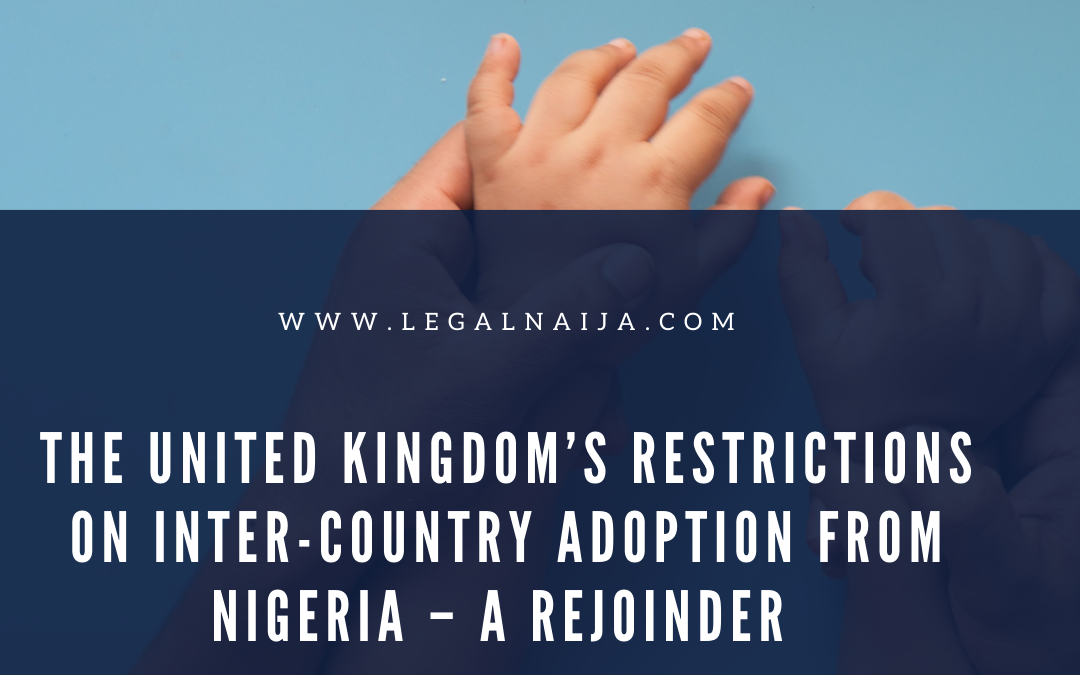
by Legalnaija | May 28, 2021 | Uncategorized
The UK Department for Education recently published the “Adoption: Restricted List” which includes the segment entitled “Nigeria: Special Restrictions on Adoptions from Abroad (Nigeria) Order 2021”. By virtue of the Order, adoptions from Nigeria to the UK were suspended with effect from 12th March, 2021.
As an adoption agency with expertise and extensive experience in inter-country adoptions from Nigeria since 2006, working in partnership with Lagos and Anambra States, we feel constrained to address the issues raised in the said circular, using Lagos state, (which has similar processes to those of Anambra state) as a reference point, to provide clarity and set the records straight.
Background
- Adoption in Nigeria is a matter of state and not federal law. This means that every state has its own adoption law, procedure and practice which may differ significantly from those applicable in other states.
- Adoption in Lagos state is a subject of the Child’s Right’s law 2007 as amended in 2015. By this law, Lagos state could be said to have domesticated the provisions of the United Nations Convention on the Rights of the Child even though Nigeria is not a party to the Hague convention. Indeed, it is an aberration to make reference to “the Nigerian adoption system” as this does not exist. Since adoption is a matter of state law, the adoption system in each state, stands and falls on its own merits.
Responses to Concerns of the UK Government
- Difficulty in confirming the background and adoptability of the children and unreliable documentation
The background of each child proposed for adoption is firmly established by a robust, formal method requiring various administrative documents and involving a transparent investigation process. This results in the establishment of the child’s adoptability by the Ministry of Youth and Social Development (MYSD). Furthermore, the adoption process is facilitated by categorized procedures for both local and inter-country adoptions. For the purpose of this article, we have provided below, the Adoption procedure for Nigerians living abroad and Adoption Documentation
- Adoption procedure for Nigerians living abroad (As published by MYSD):
- Submission of Application Letter to the Permanent Secretary, Ministry of Youth and Social Development, Block 18, Secretariat, Alausa, Lagos
- Submission of all required documents by prospective adopters or through Foundation (including Home Study Report and Approval Letter from Country of Domicile by appropriate Authorities
- Administrative Processing by the Adoption Unit
- Payment of N130,000 Administrative fees
- Processing of all documents submitted for Honourable Commissioner’s Approval
- Collection of Approval Letter by the Prospective Adopters/Foundation
- Notification of Arrival of Prospective Adopters after a successful matching of child/children at a registered orphanage
- Invitation of Prospective Adopters with their updated documents through the foundation for the release of child/children for Bonding
- Conducting Bonding Assessment
- Interview with the Director, Social Welfare
- Legalization of the Adoption at the Family Court
- Adoption Documentation
Below is the comprehensive list of documents pertaining to the prospective adoptee, used for processing international adoptions in Lagos state:
- Social Report
- Laboratory Test result
- Medical Report
- Police Report
- Clearance Letter
- Approval Letter for Adopters
- Release Letter
- Approval for Legalization
- Court Order
- Birth Certificate
- Authority to travel abroad
- Ministry’s Statement of consent
- Letter to Passport Office pertaining to application for subject’s passport
The entire adoption process from commencement to completion lasts a minimum of one year from the date of application. According to Section 121 Child’s Rights Law,
“an adoption order must not be granted in respect of a child unless…the applicant has at least twelve months before the granting of the order, informed the social welfare officer of his intention to adopt the child.”
In practice, this one year period may be abridged by the Family Court judge in exceptional circumstances if the court considers that it is in the best interest of the child.
- Concerns about corruption in the Nigerian adoption system
From the Lagos state adoption procedure and documentation highlighted above, it would be observed that the adoption process involves four separate authorities. Each authority conducts its own independent investigations before issuing any related report or document. They are:
- The Nigeria police
- The Adoption Unit, Ministry of Youth and Social Development
- The Family Court
- The Nigeria Immigration Service. (By virtue of executive directive, every Nigerian child who has been adopted must apply for a Nigerian passport exclusively through the Nigeria Immigration Service headquarters, Abuja for proper monitoring and control).
- Evidence of organized child trafficking within Nigeria.
No doubt, organized child trafficking has been found to occur in some states within Nigeria. But the above points demonstrate that such occurrence is outside the scope of formal adoptions. Trafficking is illegal while adoption is legal. Hence a trafficked child cannot fall within the purview of the adoption process.
Conclusion
All considered, our response to the concerns raised shows that the Lagos state adoption system, largely mirrored by that of Anambra state, reflects international best practices. Every adoption case is thoroughly investigated and supported by extensive and reliable documentation, particularly those confirming the background and adoptability of the child. This is in addition to a series of checks and balances aimed at avoiding corruption and advancing the best interest of every child subjected to the adoption process.
Literacy Integration & Formal Education Foundation is a Not-for-profit, Non-governmental, child/women-focused organization with headquarters in Lagos. It also acts as an adoption agency aiming to advance the interests of orphans living in institutions, by integrating them into a family.
Elvira Salleras, President, Literacy Integration & Formal Education Foundation
And
Ibrahim Saka, Programme Officer, Literacy Integration & Formal Education Foundation
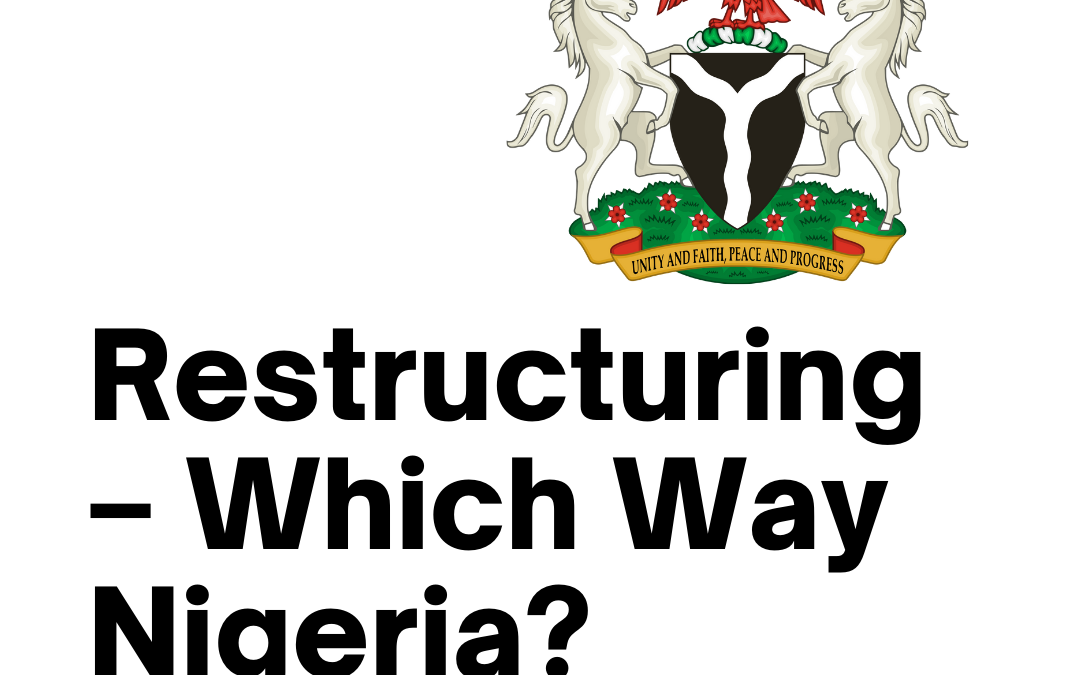
by Legalnaija | May 19, 2021 | Uncategorized
Personally the debate on restructuring Nigeria’s present configuration is one that I believe cannot be had without putting certain historical facts in context from amalgamation to the drafting of the 1999 constitution. An honest review of our history will expose a systemic failure in managing and harnessing the intricacies associated with our amalgamation thereby causing distrust, avoidable conflicts and an imbalance of power.
While the clamor for restructuring isn’t new, in fact it has become a constant robe worn by every government or its antagonists and truthfully speaking, the actions of Government to assuage these calls have always been faulty leading to bad blood and distrust instead of creating a solution.
While the Federal Government continues to amass enormous resources to the detriment of the States and Local Governments, it has in times past sought to assuage this call for restructuring by creating more states which to my mind has only compounded the problem. I do not think Nigeria has any business having the number of States it has today, I would rather have thought that a regional empowerment should be entrenched where each region is allowed to largely control its resources.
Frankly speaking restructuring as we are presently being inundated with is fraught with diverse and complex interpretations which is a large part of the problem; restructuring to the Igbos is different from restructuring to the Hausas or the Yorubas or the Edos. The understanding and interpretation of restructuring to the political class is different from what it means to the average Nigerian. What we have are fragmented clamors for restructuring from each group’s point of view and not necessarily what is best for Nigeria as a whole.
So, I think we must find a way to seat together and collectively decide what restructuring means to us, putting in perspective our peculiarities and the interest of Nigeria in its entirety.
I believe that the failure of our previous attempts at reaching a cohesive solution to the issues that affect us as a nation particularly with respect to the imbalance of power and sharing of natural resources, flows from a place of impatience and refusal to really understand the peculiarities of the federating units that make up the entity called Nigeria.
Elementary studies will show us that while one part of the country believes in a parliamentary approach to resolving issues and overseeing their affairs, another part of the country believes and adopts a monarchical approach where the word of one man is law and binding on them all. Thus, it is impossible to have these people coexist without creating a document that mirrors their realities and creates a fine admixture that doesn’t stifle one over the other.
This is where our Constitution as it is presently drafted has failed.
I am of the opinion that it was imposed on us and does not represent our peculiarities nor does it exemplify the tenets of true federalism. Make no mistake about it, our Constitution is deeply flawed, the imbalance it perpetuates amounts to injustice on everyone and it must be amended for the greater good of one Nigeria.
I have often said that what we practice in Nigeria is “convenient federalism”, our federalism needs refinement and equitable improvement; we need good governance and equitable sharing of governmental power and resources.
For meaningful impact, restructuring should mean the devolution of power and sharing of resources in accordance with the true tenets of federalism. Our Constitution should also be rejigged to meet current realities and reflect true federalism. The journey to achieve this must be holistic.
Governmental Power and control of Government Institutions must cease to be self-serving expeditions and be devoid of personal or tribal aggrandizement.
Most importantly power and resources of the Federal Government as specified in the exclusive and concurrent legislative lists must be reduced and equitably redistributed bearing in mind the realities of our nationhood and the principles of true federalism.
 OmoruyiEdoigiawerie is a Legal Practitioner with over a decade experience. Over the years, he has garnered consummate experience in corporate legal practice and statutory compliance matters. Presently he is the General Counsel at UNCTAD EmpretecNigeria Foundation a private sector initiative of the United Nations Conference on Trade and Development (UNCTAD).
OmoruyiEdoigiawerie is a Legal Practitioner with over a decade experience. Over the years, he has garnered consummate experience in corporate legal practice and statutory compliance matters. Presently he is the General Counsel at UNCTAD EmpretecNigeria Foundation a private sector initiative of the United Nations Conference on Trade and Development (UNCTAD).
His core expertise lies primarily in Corporate Commercial Practice, Startup Law, Employment law, Immigration Law, Alternative Dispute Resolution and Entrepreneurship. Additionally he regularly provides advisory and capacity building support to a spectrum of clients particularly start-ups whom he enjoys mentoring. To date he has helped build and grow over 500 starts most of who remain gainfully in business.
Omoruyiholds Graduate and postgraduate degrees in Law and is an Alumnus of the University of Lagos,Harvardx program on Leadership, he is also a Member of the Chartered Institute of Arbitrators UK, Mediation specialist and management Consultant, he is also a member of the Nigerian Bar Association and several professional bodies.
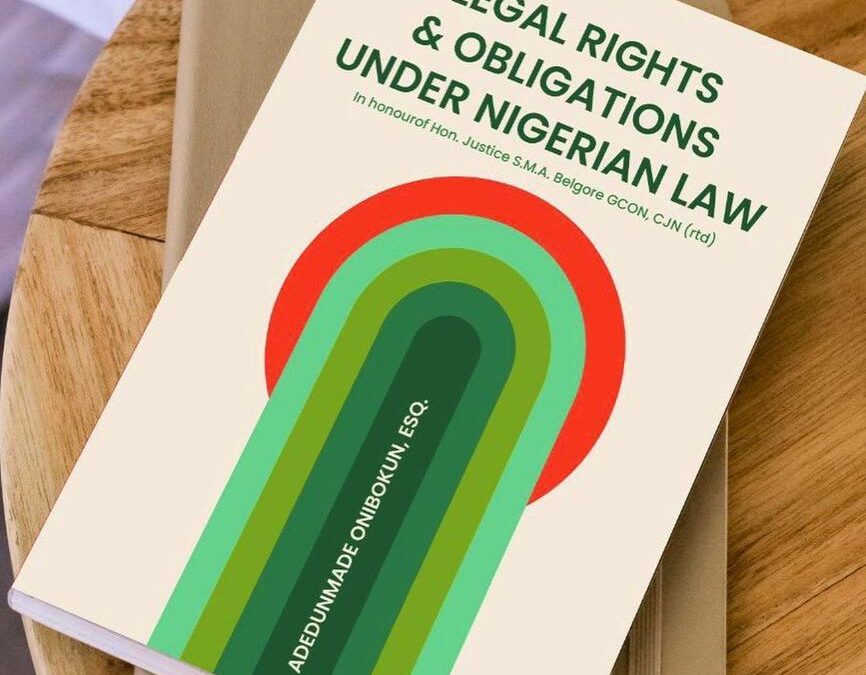
by Legalnaija | May 18, 2021 | Uncategorized
Author: Aedunmade Onibokun Esq.
Category: Ebook
This book educates the average Nigerian and visitor on Nigerian laws. It contains explainers on over 80 Nigerian laws for the benefit of the reader.
Price – 1,000
Order Your Copy Here – https://legalnaija.com/product/legal-rights-and-obligations-under-nigerian-laws/

by Legalnaija | May 18, 2021 | Uncategorized
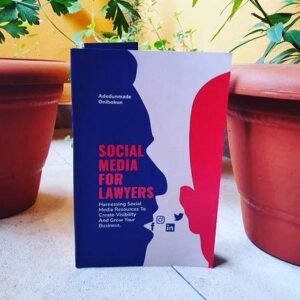 This book helps lawyers and professionals harness social media resources to create visibility, grow their practice, get more clients and grow income.
This book helps lawyers and professionals harness social media resources to create visibility, grow their practice, get more clients and grow income.
The chapters focus on the benefits of social media marketing for lawyers; how to create a social media strategy that works; available tools to help along the way, and how to convert clients from social media.
Order your copy here – https://legalnaija.com/product/social-media-for-lawyers/
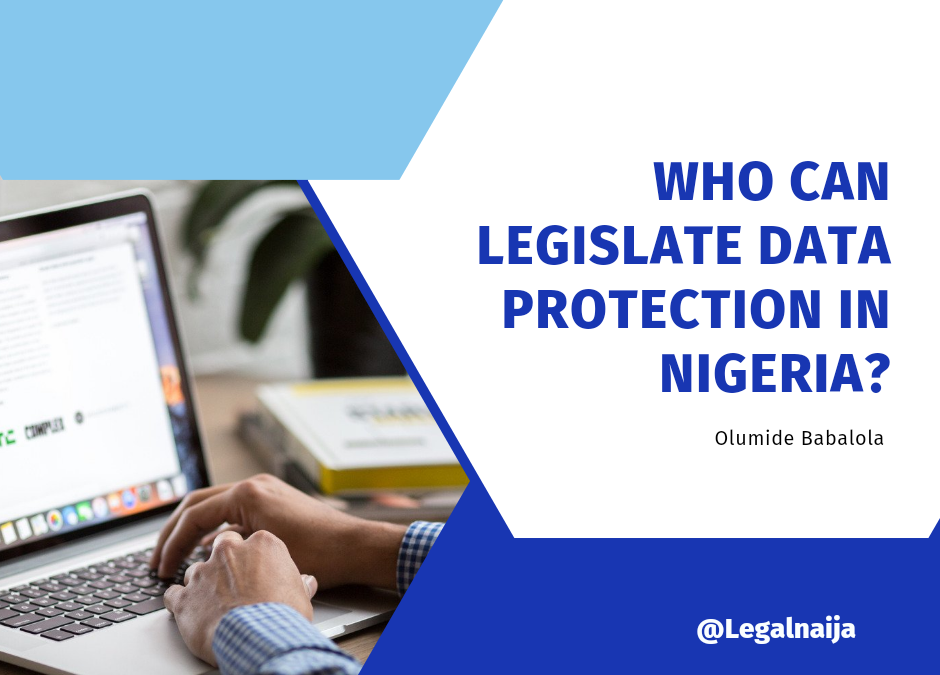
by Legalnaija | May 16, 2021 | Uncategorized
In recent times, I have had a number of stimulating on and offline conversations with privacy professionals and enthusiasts on the reasons for the dearth of data protection laws and materials in Nigeria and possible solutions.
There is no gainsaying that our country remains on the list of African Countries without a data protection law (the Nigeria Data Protection Regulation 2019 (NDPR) is not considered a law in this context). It is further sad that, in spite of being a signatory to the ECOWAS Supplementary Act on Personal Data Protection 2010, we are yet to have a principal data protection legislation.
It must however be noted that, some commendable attempts have been made by in the past by the National Assembly in the mould of the Data Protection Bill 2010 (HB 276, HB 45) and later the Data Protection Commission Bill 2019 as presented to the Executive in May 2019 but it was not deemed worthy of presidential assent for some right or wrong reasons. I also understand that two (2) Data Protection Bills are currently pending before the 9th National Assembly as sponsored by Hon. Yakubu Dogara (HB: 564) and Hon. Ndudi Elumelu (HB: 504) but not so much has been heard about the progress of these very significant bills.
However, as the Federal Government continues to, with respect, struggle in its tracks to deliver a Data Protection Act to the country, States’ Governments have also appeared uninterested in legislating data protection with the exception of one of the states in the southwest which I hear, has concluded works on a bill on data protection in readiness for sponsorship to their House of Assembly.
As it appears that, the States may come to our nation’s rescue faster than the Federal Government, we may need to interrogate the legislative competence of the various Houses of Assembly to make laws on data protection under our extant Constitution.
Data protection as a component of right to privacy.
An interrogation of legislative competence must necessarily start from first ascertaining the nature of ‘data protection’ as a concept within the context of law-making powers of the legislative houses concerned. For localization purposes, I will restrict myself to some Nigerian academics who have written on the subject for clarity on the vexed argument as to the relationship of data protection with right to privacy.
Dr. Kemi Omotubora, lecturer of Information Technology Law, University of Lagos, is perhaps, the fiercest critic of conflation of data protection and privacy. In a recent paper she co-authored with another academic from Leeds University, United Kingdom, the learned data protection lecturer decried the problematic definition of personal data because it has blurred the fine lines between the concepts of privacy and data protection that has been drawn from the inception of the data protection regime”.
However, she went ahead to acknowledged that: “Following the same track, the European courts have consistently conflated data protection and privacy and treated the former as an extension of the latter.” She referred to a number of decisions (Breyer, Volker, Rundfunk etc) reported in my Casebook on Data Protection, where the European courts ruled on the fusion of data protection with privacy. See ‘Next Generation Privacy’ Information and Communications Technology Law accessible at https://doi.org/10.1080/13600834.2020.1732055
In another co-authored paper titled “Personal Data Protection in Nigeria: Reflections on opportunities, options and challenges to legal reforms”, Dr. L.A. Abdulrauf of the Department of Public Law, Faculty of Law, University of Ilorin, states that:
“In spite of its commercial purposes, there is no denying that, data protection has its roots in the right to privacy in international human rights instruments…Thus, the normative basis of data protection is in the human rights instruments which arguably makes it human right too. While some jurisdictions do not even distinguish privacy from data protection, others have anchored their data protection laws on right to privacy. The relationship between data protection and other human rights also strengthens the argument in favour of it being a human right.”
In his contribution to a book titled “African Data Privacy Laws”, Iheanyi Samuel Nwankwo, a research associate at Institute for Legal Informatics, Leibniz Universitat, Hannover, Germany states at page 47 that:
“But irrespective of these conceptual differences, this chapter will focus on information privacy in Nigeria, that is, the aspect of the law that regulates how personal information is collected, processed, accessed, shared and stored by others….The words “data protection” and “information privacy” are used interchangeable and they are intended to mean the same thing…”
From the foregoing interventions, it appears that, from whatever perspective one decides to view ‘data protection’, the underpinning presumption, especially in Nigeria where there exists no judicial decision at the moment, favours the concept of data protection as an integral constituent of right to privacy and that is where this writer has, unassertively, chosen to pitch his tent until a defining decision is handed down by our courts.
Can State governments legislate data protection?
Apparently, “data protection” or its semblance does not exist under the exclusive legislative list but some commentators have curiously argued that, only the Federal Government of Nigeria has the legislative competence to make laws relating to data protection. Senator Ihenyen, Esq.- a consistent Information Technology Lawyer, in a data guidance note, stated that:
“Following Nigeria’s federal system, only the National Assembly has the power to legislate on broadcasting, posts, telegraphs, telephones, televisions, wireless communication and any incidental matters. This is in accordance with the provisions of the second schedule of the Constitution. The implication of this is that, if Nigeria’s federal legislature failed to legislate on data and privacy related matters, state legislators do not have the power to legislate on them”, without necessarily commenting on the aptitude or otherwise of Mr. Ihenyen’s opinion above, it is worthy of note that, item 28 of the exclusive list provides for “fingerprints identification and criminal records” which are universally classified as sensitive data covered by data protection laws, but that is not to say that, sensitive data alone forms the whole gamut of data protection to make it an exclusive matter.
Although a direct answer to the poser here cannot be found in the Constitution which does not prohibit states from legislating fundamental rights, I will attempt an answer by drawing inferences from a similar but specific data protection laws passed by States Houses of Assembly in relation to fundamental right to privacy.
Freedom of Information Act 2011 (FOIA)
The FOIA was passed in 2011 by the National Assembly to, among other things, make information freely available and for the protection of personal privacy. This Act has been repeatedly argued in various courts to guarantee freedom of expression which includes “freedom to receive information” under section 39(1) and right to privacy under section 37 of the Constitution.
In that same 2011, the Ekiti State House of Assembly followed suit when it passed its own Freedom of Information Law to make information available and protect personal privacy. Not long after that Imo and Delta States also passed their own Freedom of Information Laws which, in part, protect personal data as well.
Conclusively, although these laws are not comprehensive as far as standard data protection provisions are concerned, they are nevertheless States enactments on data protection and right to privacy.
With the absence of any item under the exclusive legislative list ceding sole powers to legislate data protection to the Federal Government, it is this writer’s respectful opinion that, States’ Houses of Assembly possess requisite legislative competence to make laws on the subject.
By: Olumide BabaBabalola

by Legalnaija | May 8, 2021 | Uncategorized
Is The Law Truly What The Court Says? | Samuel Edeh
ABSTRACT
There is no authoritative definition of law and most certainly, there will never be. Any attempt at giving a universal acceptable definition of law will be akin to forcing a camel through the eye of the needle or forcing a fish to climb a tree. Consequently, theories of law are founded to establish an understanding of the nature of law. These theories allow us to attempt the question as to what is law and what the law ought to be. Now, there are schools of jurisprudence which influences the answer. These theories of jurisprudence include, but not limited to, the positivist theory, realist theory, natural law theory, historical theory etc. The positivist believes law to be nothing more pretentious than what a recognized sovereign authority has enacted. For instance, Section 4 of the 1999 Constitution of the Federal Republic of Nigeria vested the National Assembly with the powers to make laws for the Federation. It follows, therefore, that where the constitutional procedure of law making is strictly adhered to, any law emanating therefrom is valid, nothing more, nothing less. The question as to whether it is just or unjust is inconsequential. On the other hand, the realist theory is against this view. For them, what the court says in resolving disputes is the law. In other words, the decisions of courts stand as the law. Therefore, the aim and objective of this paper is simple. It is to demonstrate that the decision of the court stands as the law – and not the provisions of statutes. By so doing, this paper will also show landmark cases wherein the court took the view of the realist. As a result, this topic will be doctrinal in nature, in other words, a desk-based or library-based research. It will rely on available literature and numerous cases on the topic. The topic will also rely on secondary sources, considering that most of the materials in this area of law are secondary sources.
INTRODUCTION
In order to have better understanding of law, it is apt to properly examine the concept called jurisprudence. Jurisprudence is a vibrant discourse in the study of law and its definition abounds.1 In fact, it is as big as law — and bigger.2 The term jurisprudence derives from Latin word jurisprudentia which according to the English Oxford Dictionary means knowledge of or skill in law. Juris means law and prudentia means science or a systematic body of knowledge. Thus etymologically jurisprudence means science of law, the science which treats of human laws in general i.e. philosophy of law. From the Romans, as we learn from Cicero, the study of law must be derived from the depths of philosophy and involves an examination of the human mind and of the human society from which rules of positive law are distilled.
There is no convincing definition of jurisprudence. Dias expresses the same opinion: the answer to the question, what is jurisprudence? is that it means pretty much whatever anyone wants it to mean. But Llewellyn believed jurisprudence to mean:
Any careful and sustained thinking about any phase of things legal, if the thinking seeks to reach beyond the practical solution of an immediate problem in hand. Jurisprudence thus includes any type at all of honest and thoughtful generalization in the field of the legal.
However, the study of jurisprudence in modern legal academia is imperative. It helps the judges in ascertaining the true meanings of the law passed by the legislature by providing the rules of interpretation. Jurisprudence does not teach law, but an examination of the law. This is the big fact in litigation. Armed with the knowledge of jurisprudence the lawyer can think beyond the relish of that statute. It is the critical thinking of what law ought to be that initiates law reforms in society. Otherwise, society will run into danger when we have static laws that draw no good and development.
Conclusively, this overview of jurisprudential purposes is not exhaustive. It can be extended. The conclusion from this survey is clear. Jurisprudence is not fixed. Undeniably, jurisprudential activities reflect countless purposes, they vary over time, they sometimes appear to controvert each other, they are not always possible to describe in detail, and they are occasionally completely implicit.
THE REALIST SCHOOL OF JURISPRUDENCE
An alternative theory to both positivism⁶ and naturalism is legal realism. Legal realists are more concerned with “law in action” rather than with “law in statute books. Legal realist holds the view that law is practical and pragmatic. It is based on the belief that judges neither do nor should decide cases formalistically. Law is not, as the positivist claimed, as system of rules that is clear, concise, consistent and complete. To a realist, statutes and case law are only sources of law, until a judge interprets and reaches a decision in a dispute and state what the law is. A major forerunner of this school of thought is Justice Oliver Wendell Holmes Jr. In his famous essay Holmes wrote:
The prophecies of what the courts will do in fact and nothing more pretentious, are what I mean by law… We must reject the view of text writers who tell us that law is something different from what is decided by the courts of Massachusetts or England, that it is a system of reason that is a deduction from principles of ethics and admitted axioms or what not, which may or may not coincide with decisions.
The above means that the pronouncement of the court is the law. Therefore, a law that has not be examined in a court is no law, not even the provisions in the statutes. Some proponent of this school believe that there should be no deviation from judicial precedents because it is the law, whereas the second group believe that precedents should not be worshipped and that activist judge can deviate from already made precedents.
Conclusively, for the legal realist, there is always a lacuna between what is and what ought to be. There are interested in what is as it has been pronounced by the court and nothing more pretentious. According to them certainty of the law is a myth until it is addressed in court.
IS THE LAW TRULY WHAT THE COURT SAYS?
In applying the proposition of Oliver Wendell Holmes and other realist proponents, it is my humbly view that in Nigeria and other democratic countries, like the United States, the law is truly the verdict of the court and the provisions in the statute books are just skeleton until given flesh and life-breath by the court.
In Donoghue v Stevenson 3, the Neighbour Principle was formulated by the House of Lords. Here, a manufacturer of ginger beer sold ginger beer in an opaque bottle to a retailer. A boy bought a bottle of the ginger beer from the retailer and treated his girlfriend to its contents. The girl alleged that that she suffered some injury as a result of seeing and drinking the contaminated contents of the beer manufactured by the defendant. The ginger beer, in fact, contained decomposed remains of a snail. Since she had not, herself, been in a contractual relationship with the proprietor, she could not sue him, and she was then forced to sue the respondent manufacturers of the ginger beer. The boy, on his part, could not sue anyone because he did not suffer any injury. The Scottish Court held that they could not find any legal connection between the girl and the manufactures. But when the case got to the House of Lords, a majority of the court held that the manufacturer owed her a duty to take care that the bottle did not contain noxious matter and that he would be liable if that duty was broken. In holding the manufacturer liable the court made tortuous liability to exist in the absence of privity of contract. According to Lord Atkins:
The rule that you are to love your neighbour becomes in law, you must not injure your neighbour; and the lawyers question, Who is my neighbour? receives a restricted reply. You must take reasonable care to avoid acts or omissions which you can reasonably foresee would be likely to injure your neighbour. Who then, in law is my neighbour? The answer seems to be — persons who are so closely and directly affected by my acts that I ought reasonably to have them in contemplation as being so affected when I am directing my mind to the acts of omission which are called in question.
From the above foregoing, the court propounded a new law and applied the newly propounded law to the instant case above. This newly promulgated law is that a person can be liable for tortuous act in the absence of any kind of relationship. It therefore means that a consumer of butter in Nigeria can maintain an action against a Ghanaian manufacturer for breach of the neighbour principle even when there is no contractual relationship between them. This principle has been replicated in some many Nigerian judicial decisions.
The Strict Liability Rule is not as result of legislative framework but as a pronouncement of the court in Ryland v Fletcher.4 Also this decision has been replicated in some many Nigerian judicial decisions.5 The defendant, in this case, employed independent employed independent contractors to construct a reservoir on their land. While carrying out the work, the independent contractors discovered some disused shaft beneath the site of the reservoir which connected their land with plaintiffs mine. They negligently did not block them up because the shafts appeared to be filled with sand. When the reservoir was completed and filled with water, the water escaped down the shafts and flooded the mine of the plaintiffs. The defendants were held liable under the rule of law established by Blackburn J:
We think that the true rule of law is that the person who, for his own purposes brings on his lands and collects and keeps there anything likely to do mischief if it escapes must keep it at his peril and if he does not do so, is prima facie answerable for all the damage which is the natural consequence of its escape.
Further, the belief that law is the prophecies of the court was ventilated in the epoch-making judgment of the United States Supreme Court in Obergefell v Hodges6 which legalized same- sex marriage in all 50 States in America. This case marked a defining moment in the history of the United States. It successfully brought to end many years of raging debates over the legality of or otherwise of gay marriage in the United States. The Supreme Court did not base its decision on any statute/law. The Court employed the Individual Autonomy Principle to legalize gay marriage. Justice Kennedy who led the majority judgment of 5-4 has this to say:
Expanding a right suddenly and dramatically is likely to require tearing it up from its roots… This free — wheeling notion of individual autonomy echoes nothing so much as the general right of an individual to be free in his person and in his power to contract in relation to his own labour.
He further stated as follows:
If you are among the many Americans of whatever sexual orientation — who favour expanding same — sex marriage, by all means celebrate todays decision. Celebrate the achievement of a desired goal. Celebrate the opportunity for a new expression of commitment to a partner. Celebrate the availability of new benefits. But do not celebrate the constitution. It had nothing to do with it.
The above dicta clear shows that the decision has not nothing to do with the Constitution but enhances the view that the law is nothing more but the prophecies of the court.
Having meticulously considered the application of the realist theory in foreign cases, it is also mandatory, for the purpose of elucidation, to establish its existence in our legal jurisprudence. Under the Nigerian criminal jurisprudence, a defendant may claim that a certain set of facts or events happened which ought to exonerate him from criminal liability. And such eventualities are called defences. The law is very much settled that any defence to which an accused person is, on the evidence entitled to, should be considered for what it is worth however stupid or unreasonable it might appear to the court. However, from the clear wording of section 318 of the Criminal Code Act it is highly possible to submit that where the defence of provocation succeeds in a charge of murder, the defendant is to be convicted for manslaughter. He is not to be discharged and acquitted. This is settled law.
But, the Supreme Court in Shande v. The State7 made a u-turn. The appellant caused the death of the deceased (her husbands lover). She poured kerosene on the deceased and lit her on fire. She was charged with culpable homicide under the Penal Code Act. She pleaded provocation. She was convicted at the trial court and her conviction was upheld by the Court of Appeal, hence her appeal to the Supreme Court. After holding that the defence of provocation suffices, the Supreme Court went ahead to discharge and acquit her. This is against the position that provocation as a defence does not excuse the offence of murder. And it appears that the Supreme Court had jettisoned such laid down principles of law.
Further, the decision in Rt. Hon. Amaechi v INEC & Ors8 re-enforces our claim that the law is what the court says and nothing more. In 2007, the appellant (henceforth Amaechi) contested in the primary election for the gubernatorial candidate of Peoples Democratic Party (henceforth PDP). Amaechi emerged as the winner of the PDP primaries. His name was transmitted to the Independent National Electoral Commission (henceforth INEC) as the gubernatorial candidate of PDP. Sometime thereafter, Amaechis name was substituted with that of Omehia (who did not event participate in the primary election). Dissatisfied, Amaechi approached the Federal High Court seeking inter alia a declaration that he remained the lawful candidate of PDP for the election because no cogent and verifiable reason was given by PDP for the substitution of his name with that of Omehia as provided under 34(2) of the Electoral Act 2006. The Federal High Court upheld the substitution. Amaechi appealed to the Court of Appeal. Before the appeal was heard, Amaechi was expelled from PDP. On this note, PDP and INEC asked that the Court of Appeal to struck out the appeal on the ground that the Court no longer had the jurisdiction to her the appeal as a result of the expulsion of Amaechi from PDP. The appeal was struck out. Dissatisfied Amaechi appealed to the Supreme Court. But before the Supreme Court heard the appeal on its merit, elections have been concluded in Rivers State and Omehia was declared the winner. And having held that Amaechis name was unlawfully substituted, the Supreme Court was faced with difficulties as to reliefs entitled to Amaechi bearing in mind that election has been held and on the other hand, Amaechi never contested for the gubernatorial election. The central issue was: whether to declare a person who never contested for an election (gubernatorial) winner; which on the other hand is against the spirit of the Electoral Act, 2006. In his augment in the brief filed for PDP, J.K Gadzama SAN argued that Amaechi who had not contested the election could not be declared the winner. He stated that such a declaration would amount to a negation of democratic practice. Adesola Oguntade JSC held as follows:
Am I now to say that although Amaechi has won his case, he should go home empty- handed because elections had been conducted into the office? That is not the way of the court. A court must shy away from submitting itself to the constraining bind of technicalities… it is futile to merely declare that it was Amaechi and not Omehia that was the candidate of the PDP. What benefit will such a declaration confer on Amaechi?
From the above, it follows, therefore, that there may be circumstances where a person who never contested in an election could be declared the winner as was decided above. This led to a jurisprudential war in the Nigerian legal system. The National Assembly did not admire this trend in electoral matters. As a result, they caused an amendment to be made in 2010 to the Electoral Act of 2006. This amendment added a new provision to the Act. It added section 141. It provides as follows: An election tribunal or court shall not under any circumstance declare any person a winner at an election in which such a person has not fully participated in all the stages of the said election.
Hence, if Amaechis case was to be re-litigated under the above provision, he would not have been declared the winner of the election. It is the duty of the legislature, of course, to enact laws for the country. However, it remains the duty of the courts to interpret those laws made by the legislature and a law, as least to a realist, can never by anything other than the prophecies of what the courts will do in fact and nothing more pretentious.
In Gwede v Independent National Electoral Commission9, the Supreme Court was confronted with a case having similar facts with that of Amaechis case because it involves unlawful substitution too. The 2nd respondent, Akpodiete won the primary election of DPP for Ughelli North Constituency II, Delta State. He later withdrew from the election in writing consequent upon which his two-million-naira deposit was refunded to him. DPP substituted him with the appellant and it was published by INEC. Subsequently, INEC substituted the appellant with the 2nd respondent. The appellant brought an action at the Federal High Court challenging the substitution. The Court declined jurisdiction. On appeal to the Court of Appeal, it was held that the substitution of the appellant was unlawful and dismissed all the reliefs sought by the appellant. On further appeal to the Supreme Court, the court in its considered judgment on 24 October 2014 affirmed the candidacy of the appellant but was again faced with the appropriate relief to grant. The Court escaped the handcuffs of section 141 and ordered the certificate of return be issued to the appellant.
The above clearly shows that the decision of the court on this issue is the law and not the provisions of the Act made by the lawmakers. Despite the subsequently amendment of the Electoral Act, the court still went ahead to deviate from such provision. It applied its previous decision (Amachis case) which the purported amendment has abrogated.
In property law, our court has made a significant rule of law on proof of ownership of land. Before the case of Idudun v Okomagba,10 there was dearth or no provision for proof of ownership of land in our statute books. The above case formulated the Proof of Ownership Rule. Thus, a person who is seeking declaration of title to a disputed land, can succeed by proving any or a combination of the following five ways: (1) by traditional evidence (2) by acts of selling, leasing, renting out all or part of the land or far on it or on portion of it (4) by acts of long possession and enjoyment of the land (5) by proof of possession of connected or adjacent land in circumstances rendering it probable that the owner of such connected or adjacent land would, in addition, be the owner of the land in dispute.
On national security and interest, our court has made a judicial pronouncement to this effect. And which is now the law. In Dokub-Asari v Federal Republic of Nigeria, the Supreme Court per Muhammed JSC (CJN Rtd) had the following to say:
Where national security is threatened or there is real likelihood of its being threatened, human rights or individual rights of those responsible take second place. Human right or individual rights must be suspended until national security can be protected or taken care of. This is not anything new. The corporate existence of Nigeria as a united, harmonious, indivisible and indissoluble sovereign nation is certainly greater than any citizens liberty or right. Once the security of this nation is in jeopardy and it survives in pieces rather than in peace, the individual liberty or right may not even exist.
The above declaration simply means that the nations security cannot be sacrificed on the altar of individual rights and rule of law. It even appears that the legislature cannot make any law where the individual right of any individual will supersede that of national interest. It is on the basis of this verdict that the Buharis administration is unwilling to release Col. Sambo Dasuki (erstwhile National Security Adverse) and El-Zakzaky (the leader of the Shiite Islamic Movement of Nigeria). President Buhari, while speaking on the 2018 Annual General Conference of the Nigerian Bar Association (NBA) revalidated the verdict when he said:
Our apex court has had cause to adopt a position on this issue and it is now a matter of judicial recognition that; where national security and public interest are threatened or there is a likelihood of their being threatened, the individual rights of those allegedly responsible must take second place, in favour of the greater good of society.
This is recognition by the executive arm, hence, the law.
There are sometimes where the law will be uncertain, contentious and controversial. It is not the legislature that will clear the contentious matter. It is the court. On the 30 June 2017, the Supreme Court of Nigeria in Skye Bank Plc v Iwu was called upon to interpret the constitutional provisions below. It relates to the appellate jurisdiction of the Court of Appeal over the decisions of the National Industrial Court which was before now shrouded in deep controversy. The constitution under section 243(3) (4) provides:
(2) An appeal shall lie from the decision of the National Industrial Court as of right to the Court of Appeal on questions of fundamental rights as contained in Chapter IV of this Constitution as it relates to matters upon which the National Industrial Court has jurisdiction.
(3) An Appeal shall only lie from the decision of the National Industrial Court to the Court of Appeal as may be prescribed by an Act of the National Assembly ….
The above simply means an appeal emanating from the decision of the National Industrial Court shall lie to the Court to Appeal as of right where it borders of fundamental human rights provisions under the constitution and an appeal shall lie from the decisions of the National Industrial Court to Court of Appeal as may be prescribed by an Act of National Assembly. But the Supreme Court disregarded these provisions. Per Mary Peter-Odili JSC has this to say: [T]he appellate jurisdiction of the Court of Appeal is not foreclosed within matters only related to fundamental right, rather, the appeals from the National Industrial Court all can go on appeal to the Court of Appeal as of right… Again, Per Clara Bata Ogunbiyi JSC, held: I hold the firm view that all decisions of the National Industrial Court are subject to the review of the Court of Appeal.
The foregoing vividly shows that the court has a choice between alternative meaning of the provisions of a law and it may choose to follow it or reach the decision it wishes.
CONCLUSION
This work has done three basic things. First, it made a critical appraisal of jurisprudence as an imperative study in law. Second, it introduced the realist approach from foreign dimension15. And third, it applied it to our contemporary Nigeria. Law is best described as a complex of rules and reactions emanating from legislative direction, native culture, executive actions and public realities, operating either jointly or independently, but they all have little effect on what judges actually do in Nigeria.
Finally, the duty of a judge is not always a pure deductive reasoning and unbending application of the law to the case he has to decide, because in many cases, the law is neither definite nor satisfactory. I shall conclude this paper by saying that law means no more than decisions of judges. Law is best depicted by what happens in court. In other words, the provision of statues does not; and cannot disclose what courts will do when actual disputes call for determination. For Llewellyn, the paper rules or the pretty playthings have little effect on what judges actually do. As replicated above, the law, in my view, is, always been restricted to and will never cease to be restricted to only judicial pronouncements.
References:
- H.H Mensah Jurisprudential Aspects of Law and Punishment in Nigeria [1996] (38) (184) Journal of the India Law Institute; F.S.C Northropt Contemporary Jurisprudence and International Law [1952] (51) The Yale Law Journal 5; <https://www.marrian-webster.com/dictionary/jurisprudence> Accessed 11 May 2019;
- Karl Nickerson Llewellyn Jurisprudence (1961) 373 cited in Ese Malemi The Nigerian Legal Method: The Theories of Law (Lagos: Princeton Publishing Co Ltd) 18.
- [1932] A.C. 562.
- [1865] 3 H.&C. 774; 159 E.R. 737 (Court of Exchequer).
- In Oladehin v Continental Textile Mills Ltd [1975] 11 SC 155, the defendants were held liable for the escape of industrial waste water which damaged the plaintiffs house. See also Shell Pet. Dev. Co (Nig) Ltd v Amaro [2000] 10 NWLR (Pt 675) 248; Machine Umudje & Anors v Shell [1975] 9-11 SC. 155 at 172; NEPA v Alli [1992] 8 NWLR (Pt 259) 279.
- 576 U.S. — (2015).
- [2005] 40 WRN 145; [2005] 12 NWLR (Pt 939) 301 (SC).
- (2008) 5 NWLR (Pt 1080) (SC).
- (2014) 18 NWLR (Pt 1438) 56 (SC).
- [1976] 9-10 SC, Page 227 at 248.
- . E. Samuel Chukwuemeka [2020] Major Theories of Law Explained; <https://bscholarly.com/schools-of-thought-in-law/> Accessed 11 May 2021;
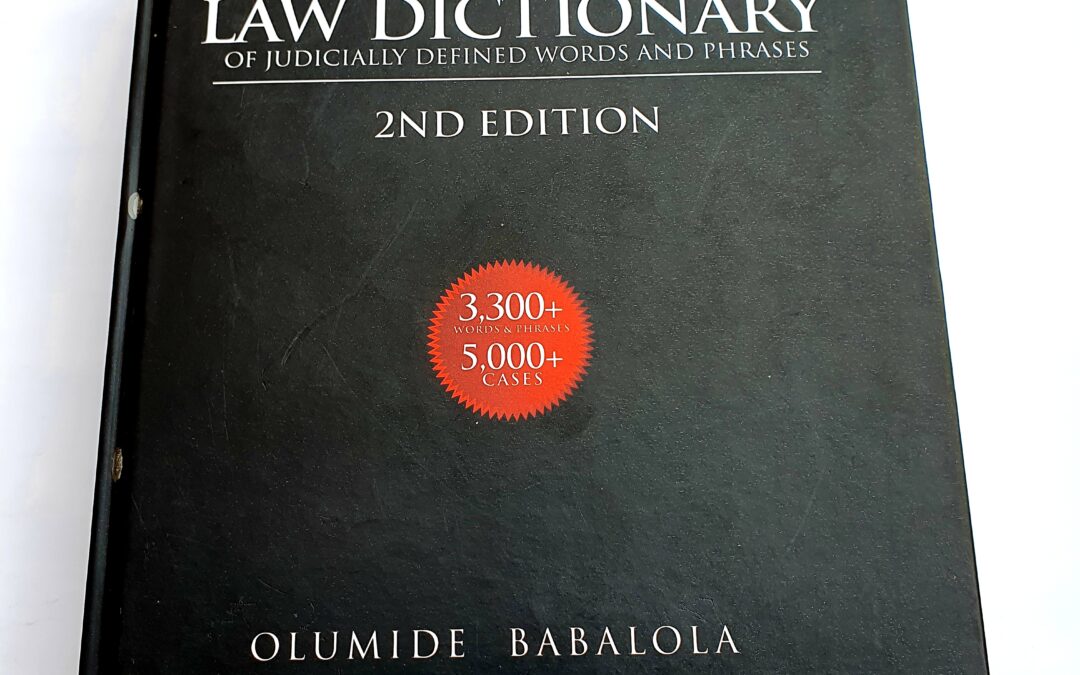
by Legalnaija | May 8, 2021 | Uncategorized
Title: Babalola’s Law Dictionary Of Judicially Defined Words And Phrases (2nd Edition)
Editor: Olumide Babalola
About
Babalola’s Law Dictionary Of Judicially Defined Words And Phrases (2nd Edition) lists over 3300 definitions and cites over 5000 cases. The Dictionary remains a must have for every lawyer, law firm and law student.
Cost: N5,000
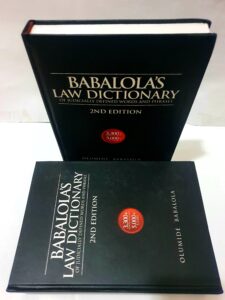
Order Link: https://legalnaija.com/product/babalolas-law-dictionary-2nd-edition/

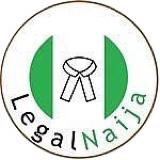





 OmoruyiEdoigiawerie is a Legal Practitioner with over a decade experience. Over the years, he has garnered consummate experience in corporate legal practice and statutory compliance matters. Presently he is the General Counsel at UNCTAD EmpretecNigeria Foundation a private sector initiative of the United Nations Conference on Trade and Development (UNCTAD).
OmoruyiEdoigiawerie is a Legal Practitioner with over a decade experience. Over the years, he has garnered consummate experience in corporate legal practice and statutory compliance matters. Presently he is the General Counsel at UNCTAD EmpretecNigeria Foundation a private sector initiative of the United Nations Conference on Trade and Development (UNCTAD).

 This book helps lawyers and professionals harness social media resources to create visibility, grow their practice, get more clients and grow income.
This book helps lawyers and professionals harness social media resources to create visibility, grow their practice, get more clients and grow income.


